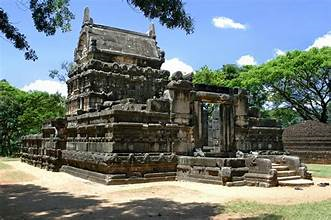…Nalanda Gedige…
Nalanda Gedige: A Unique Blend of Ancient Sri Lankan Architecture
Nestled in the picturesque Matale District of Sri Lanka, Nalanda Gedige is a fascinating archaeological site that showcases the island’s rich cultural and architectural heritage. Often described as a hidden gem, this ancient structure stands as a testament to the fusion of Buddhist and Hindu architectural styles, offering insight into the diverse religious influences that have shaped Sri Lanka’s history.
Historical Background
Nalanda Gedige is believed to have been built between the 8th and 10th centuries, though the exact date of its construction remains uncertain. The temple complex was originally located in the village of Nalanda, but was relocated to its current position in the early 20th century due to the construction of the Kalawewa reservoir, which threatened to submerge the site.
The monument is often associated with the Kingdom of Polonnaruwa, a period during which Sri Lanka saw the flourishing of both Hinduism and Buddhism. Nalanda Gedige is thought to have served as a Buddhist temple, though its design incorporates features of Hindu architecture, reflecting the intermingling of religious traditions at the time.
Architectural Significance
One of the most striking features of Nalanda Gedige is its unique architecture. The structure is built in a traditional South Indian Hindu style, but with clear Buddhist influences, making it a rare example of a cross-cultural architectural fusion. The temple is constructed of stone and brick, with intricate carvings and detailed sculptures that depict both Hindu and Buddhist iconography.
The building itself is relatively small, with a rectangular base and a circular, dome-like structure on top, resembling a traditional stupa. The walls are adorned with carvings of deities and scenes from both Buddhist and Hindu mythology, making it a fascinating study in religious and cultural exchange.
Nalanda Gedige’s construction is particularly noteworthy due to the craftsmanship of the stonework, with the use of finely cut granite and the precision of the intricate stone carvings. The temple is considered one of the finest examples of stone architecture in Sri Lanka, showcasing the skill and artistry of the craftsmen of the era.
The Symbolism of Nalanda Gedige
Nalanda Gedige’s dual religious significance reflects the complex spiritual history of Sri Lanka. During the period of its construction, the island experienced a blend of Buddhist and Hindu beliefs, particularly under the influence of Indian culture. The intricate sculptures found at Nalanda Gedige depict both Buddha figures and Hindu gods such as Shiva and Vishnu, symbolizing the harmonious coexistence of these two belief systems.
The structure’s design and sculptures are thought to have been intended as a space for meditation and worship, serving the needs of both Hindu and Buddhist pilgrims who visited the site. It is a place where the spiritual practices of two major religions of South Asia merged, creating a cultural and religious synergy that is rare in Sri Lankan temples.
Relocation and Preservation
The site’s relocation in the early 1900s was an important move to ensure its preservation. The temple was dismantled and moved to its current location in the village of Nalanda, near the Kalawewa reservoir. This relocation was carried out with great care to preserve the architectural integrity of the structure. Today, Nalanda Gedige stands as a well-preserved historical monument, protected by Sri Lanka’s Department of Archaeology.
The preservation efforts have ensured that Nalanda Gedige remains an important symbol of Sri Lanka’s rich cultural past. The site continues to attract visitors who are interested in learning about the history, architecture, and religious practices of ancient Sri Lanka.
Visiting Nalanda Gedige
For those interested in Sri Lanka’s rich history and architecture, Nalanda Gedige offers an insightful experience. Visitors can explore the site’s stunning carvings and stonework, with several panels depicting ancient deities and mythological scenes. The peaceful surroundings of Nalanda Gedige also provide an ideal setting for reflection and contemplation.
Though less visited than some of Sri Lanka’s other historical sites, Nalanda Gedige offers an authentic glimpse into the island’s cultural heritage. The site’s serene atmosphere, combined with its fascinating history and architectural beauty, makes it a worthwhile destination for those seeking to explore Sri Lanka’s past.
Conclusion
Nalanda Gedige is a remarkable site that embodies the cultural and religious syncretism that characterized Sri Lanka’s ancient history. Its unique architectural style, blending both Hindu and Buddhist elements, stands as a testament to the diverse spiritual traditions that have shaped the island over the centuries. Whether for its historical significance, its architectural beauty, or its serene ambiance, Nalanda Gedige is a must-visit for anyone interested in Sri Lanka’s rich and varied cultural heritage.

